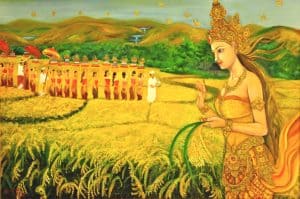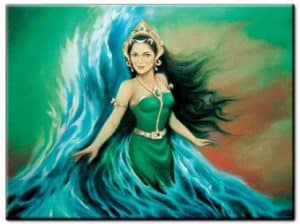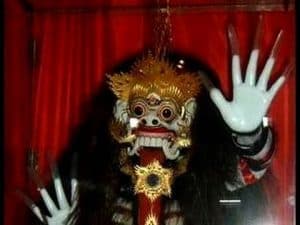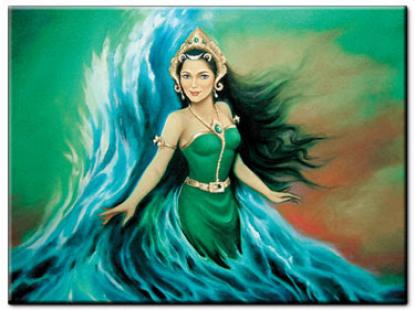If we talk about mythology, our mind probably flew up to Greece, Roman or maybe Egypt. Those countries has a popular myth that can even called as a universal myth. Greece has their god’s mythology like Zeus, Hades and etc and Egypt has the Spinx and many more. Then, what about Indonesia? Indonesia also has some popular Mythology that even exist in almost every Provinces. The myths are various, it could be a habits, a spirits, or something else that sometimes even urge to do some rituals.
See also: Bali Facts – Bali Tribes
Through the long journey, Indonesia has passed a lot of development including in the terms of beliefs and religions. In the past, Indonesian people follows the worldwide’s ancient beliefs that are Animism and Dynamism. In Animism and Dynamism, people belief that all creatures or things, and even human handiwork, wheathers, even words in the world possess a distinctive spirits.
Those beliefs are told from the generations to generations and still alive even in the time Indonesia accepts other religions like Buddhism, Hinduism and Islam. The belief adapted and grow. By the time of the world’s modernization and technology, Those beliefs that cannot be verified became a myths. However, those are rooted in the culture of the community and until now still exist in Indonesia.
See Also : Indonesian Tribes – Largest Cities In Indonesia
Definition of Mythology
Before we talk more about the mythology, it’s better to know what is mythology helps us know in advance the sense of mythology. So, what is mythology? Mythology is a common use in a term of education of a myth. Mythology refers to the various collected myth of the community.
A Myth is a story told from the previous generations to the next generations and became a feature of every culture. The story explain nature, history and customs. It is often supernatural and explaining the origins of a cultural practice or natural phenomenon and it can also a story which explain why something exist.
A myth can be a sacred narrative story because it holds spiritual significance for those who tell it. Myths also contribute to and express a systems of cultures both thought and values. Myths stories are currently understood as being exaggerated or fictitious, because sometimes it cannot be verified at all.
See Also : Indonesia Lifestyle – endangered animals in Indonesia
History of Mythology
There are four views within studies of mythology regarding their origins. There are four theories considered as the origin of the myth, they are :
- Euhemerism
The first theory about the origins of a myth is Euhemerism. According to this theory, the myth is an actually historical events that really occurred. The narration of the myths repeatedly explained about historical events or figures in the story gets status as a deities or a demons. For example, the myth of the wind god Aeolus evolved in the history about the king. He taught his community to sail and use the wind for his needs. This theory is called Euhemerisme, from a mythological Euhemerus which estimates the Greek gods developed from legends about human.
See also : History of Jakarta – Indonesian heritage
- Allegory
This theory argue that the myth appeared as an allegory. Allegory is a figure of speech that describes a purpose without literature. So in this theory, myth began as allegories for natural phenomena. For example, Apollo to represent fire, Poseidon represents water and so on.
In addition to explain natural phenomena, myths as allegories also explains the concept of philosophical or spiritual, meant as a form of nature of human nature. As the example, Athena as a representative nature of wisdom, Aphrodite as a representation of human passion, and so on. The proponents of this allegory is Max Muller, according to Max Muller, myths began as allegorical descriptions of nature, then slowly to be taken literally like, a poetic explanation of the phrase “The sea was angry,” thought of as a god who is angry etc.
See also : Indonesian Red Cross Society – Indonesia Jamu
- Personifications
This theory explains the myth is a result from the personification of objects and inanimate objects. People in the past may worship a natural things such as fire, water etc and referred them as gods. For example, in theory Mitopoeic, the previous peoples tend to see things as a person, not an object.
Thus, they explain natural events as acts of god, and then the myth created. Mitopoeic thought is the stage before the modernisation of human thought. human assume each incident as an act or a part of human desire. This theory, explain the human tendency to make the previous myth and the natural things are an act of god and the spirits.
See also : Indonesian heroes – Indonesian human rights
- Myth-Ritual Theory
According to the myth-ritual theory, the existence of myths tied to the rituals. This theory argue that myths appear to explain the ritual. This theory first described by William Robertson Smith. According to Smith, the ancients tend to be conservative to their rituals, and make sure to pass them down faithfully. However, the ritual had somehow forgotten, and then the myths come down to the next generations as the myth to change the real nonmythical reason about the ancient’s ritual.
See also: Balinese Dance – Indonesian Wedding Culture
Types of Mythology
Commonly, the myth story in Indonesia divided into two types. In Indonesia, all the myth story can be about Deities and Demons in common. Deity refers to a person or thing as a god or goddess it is typically sacred, even in some cultures there is a special ritual regards the god or the goddess in the myth of its society. While demons are evil spirit, sometimes it derived from urban legends.
Deities
There are a lot of believed deities in Indonesia. Some cultures even hold a ceremony or ritual to these gods, here some example :
- Barong
 The battle between Barong and Rangda represent the eternal battle between good and evil and it is featured in Barong dance, the traditional dance of Bali.
The battle between Barong and Rangda represent the eternal battle between good and evil and it is featured in Barong dance, the traditional dance of Bali.
See also :
- Dewi Sri
 The story of Dewi Sri is associated with the mythical origin of the rice plant.
The story of Dewi Sri is associated with the mythical origin of the rice plant.
Until now, Dewi sri still widely worshiped on Bali and Java. Dewi sri believed to have dominion over birth and Life, controls rice, hence prosperity. Especially rice surpluses for the wealth of kingdoms in Java, poverty, famine, hunger, disease and Death.
See also :
- Nyi Roro Kidul
 Nyi Roro Kidul or spelled as Nyi Roro Kidulis an Indonesian goddess of the sea. She is the Queen of the Southern Sea in Javanese and Sundanese mythology.
Nyi Roro Kidul or spelled as Nyi Roro Kidulis an Indonesian goddess of the sea. She is the Queen of the Southern Sea in Javanese and Sundanese mythology.
Nyai Roro Kidul is often illustrated as a mermaid. This mythical creature is claimed to take the soul of anybody she wished forand she usually prefers handsome young men.
The role of Nyai Roro Kidul as a Javanese Spirit-Queen became a popular in traditional Javanese folklore as well as being tied in with the beauty of Sundanese and Javanese princesses.
See also: Biggest Earthquake in Indonesia – Indonesian military power
Another aspect of her mythology was her ability to change her looks several times a day, she change her appearance as a beautiful young woman during full moon, and appear as an old woman at other times.
- Ebu Gogo.
- Hainuwele.
- Hudoq.
- Hyang.
- Ratu Adil.
- Silewe Nazarate.
- Warak ngendog.
See Also : Balinese Dance
Demons
- Leyak
 Leyak is a mythological creature in the folklore of Bali. The figure is in the form of flying head with entrails consist of heart, lung, liver still attached.
Leyak is a mythological creature in the folklore of Bali. The figure is in the form of flying head with entrails consist of heart, lung, liver still attached.
Leyak believed able to fly trying to find a pregnant woman in order to suck her baby’s blood or a newborn child.
Based on the myth, there are three legendary Leyak that are two females and one male. It is believed that they are actually humans who are practicing black magic and have cannibalistic behavior. The Leyak’s queen is a widow witch named Rangda.
See also: Gamelan Facts – Luwak Coffee
Rangda plays a prominent role in the Balinese rituals. The queen’s mask is kept in the village death temple. During the temple festivals, the mask is paraded.
- Babi ngepet
Babi Ngepet is an Indonesian Mythology as a boar demon. According to the myth, the creature is believed to be the manifestation of a person practicing a kind of magic to help people become rich instantly.
However, must sacrifice something as an exchange. In the case they must sacrifice their humanity, they transformed into a boar for a period of time or that they allow themselves to be possessed by a boar demon. This transformation is similar to the werewolf concept in the West.
See also: Poverty in Indonesia – Best Airports in Indonesia
- Suanggi
Suanggi is a mythological creature in the folklore of the Maluku Islands, Indonesia. According to the belief, Suanggi is an evil spirit in the shape a person having magical power to cause disease and illness. It is believed as a Moluccan Malay term for villagers suspected of being cannibal witches. Those who were allegedly proven to be a Suanggi would be killed and their corpses would be thrown into the sea.
- Jelangkung.
- Kuntilanak.
- Tuyul.
- Pocong.
- Etc.
See Also : Indonesian Women Rights
Kinds of Mythology in the Ethnics of Indonesia
Myths in Indonesia are so popular, The people still believe a lot of myths till today. Even the symbol of Indonesia is actually a mythological creature, The symbol use the mythological creature named Garuda. However, the symbol and the myths are slightly different.
Based on the myth Garuda is the vehicle of Lord Vishnu in Hindu teachings. It’s figure is ike a hawk-headed, human body, gold-colored body, white face and red wings. Garuda described gallant and brave, and has a drawn enormous body. It is so big, and believed to be able to block the sun with it’s body. Beside that, Indonesia consist of hundreds of ethnic groups, each ethnic has their own myths that explain the origin of their people, their ancestors, and the demons or deities in their community.
See also: Indonesian Tea – Indonesian politics
-
West Sumatera
 People belief that orang bunian shapes resemble to a human being and mentioned that orang bunians are also have hands, feet, head, and the other organs like human beings.
People belief that orang bunian shapes resemble to a human being and mentioned that orang bunians are also have hands, feet, head, and the other organs like human beings.
They belief that Orang bunian live in deserted places like forests and in empty abandoned home. According to the myth, when there’s a distinc aroma smells like a fried potato, means that orang bunian is around.
See also : indonesian language – Indonesia Religion
2. Jambi
 For the people around Kerinci, Jambi, the mythological figure that very popular is Cindaku.
For the people around Kerinci, Jambi, the mythological figure that very popular is Cindaku.
Cindaku believed as a figure of a man who is able to turn into a tiger man. Cindaku is in charge of maintaining the harmony between the Tigers and Humans. Only those who have pure blood and a strong spiritual bond that could be a Cindaku.
Moreover, Kerinci community believe that their ancestor was a tiger and obviously that’s make the bond between them and the tiger is very strong.
3. West Java
Ahool is a mythological creature believes in around the mountain of Salak, West Java. Ahool portrayed as someone who has the shape of a bat, that is not a batman though. It has wings extending along 12 feet.
According to the myth, Ahool live in a place that is still rarely explored by humans. This mythological creature called ahool because of his voice. Because sometimes in the night, Ahool would give a deafening voice, sounds like “Ahoooooool”.
See Also : Indonesia Java
4. Central Java
 One of the myth that closely related to the city of Semarang is a Warak Ngendong. Warak ngendong considered as a unifying symbol of harmony in the residents of Semarang, even since before the city of Semarang established.
One of the myth that closely related to the city of Semarang is a Warak Ngendong. Warak ngendong considered as a unifying symbol of harmony in the residents of Semarang, even since before the city of Semarang established.
It is described as a small dragon who carry eggs. However, it is not just any dragon, the shape of Ngendog Warak is a true blend of three cultures, His head is a dragon like the one in a myth of Chinese ethnic, and the body is described like Buraq according to Arab culture, while the four legs like the one in the Javanese culture.
See also : Indonesian cultures – Unique Facts about Indonesia
5. East Java
Banaspati is one of all the mythological creature that it’s existance still believed until today. This mythological creature is one of the dreaded evil in the Java community. Banaspati figure is flame shapes like a fireball that often hovering in the night. Banaspati believed able to harm a human.
See also : Indonesian democracy – Indonesian Martial Arts
6. East Kalimantan
 Lembuswana is a mythological creature from Kutai, East Kalimantan. It is described that it’s have the head of a lion, an eagle wings, have an elephants trunk, and scaly fish.
Lembuswana is a mythological creature from Kutai, East Kalimantan. It is described that it’s have the head of a lion, an eagle wings, have an elephants trunk, and scaly fish.
It is believed to be the master of the Mahakam river a Kutai protector. Lembuswana is very famous among the people of Kutai, It is became a symbol for the Kutai Kingdom.
Even now, Lembuswana’s sculpture stands proudly as the protectors of Kutai people.
See also : Indonesian heroes – Indonesian human rights
7. Maluku
In the Seram island of Maluku there is a mythological creature named Bati. Bati believed to have a body shape like a monkey, but has wings like a bats. This creatures are also described as having a height of 1.6 meters with a bright red body color. According to the Seram people, Bati live in the area of Mount Kairatu and it only came out at night and look for the kids as it’s food.
See also :
8. Flores
Ebu gogo is one of mythological creature believed to live on the Flores Island. Literally, Ebu Gogo means grandmother who eats everything. The creatures were described as having high that no more than one meter with a body covered with feathers.
According to Flores community, this little creature has an evil and greedy nature, it is often eats human babies greedily. That’s why it is called “grandmother who eats everything”. This mythical creature also called The Flores Hobbit.
See also: Indonesian People – Indonesian Traditional Transportation
The Development of Mythology in the New Era
Myths are created by human imagination. In the past with all the limitations, people could not prove how something be or do scientifictly. The natural instinct of a human to be curious for something, lead their imagination to create the story. Nothing to prove, so, the story just goes and believed in a massive way, goes generations to generations until now.
See also :
Today, with the knowledge and technology people able to do a research about almost anything. With the technology and the research, people now days able to sort the myth based on the facts they found. Myth which are provable still last until now. Then, the unreliable myth slowly disappear and become just a collection of story, just some of the people in certain areas still believe in the myth through their whole life.
See Also : Bali Facts – Indonesian National Flower
